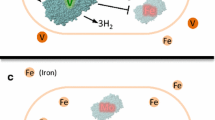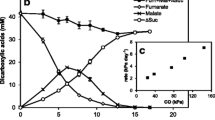Abstract
Hydrogen oxidation and electron transport were studied in the chlorobenzene-utilizing anaerobe Dehalococcoides sp. strain CBDB1. While Cu2+ and Hg2+ ions irreversibly inhibited hydrogenase activity in intact cells, Ni2+ ions inhibited reversibly. About 80% of the initial hydrogenase activity was inactivated within 30 s when the cells were exposed to air. In contrast, hydrogenase was active at a redox potential of +10 mV when this redox potential was established anoxically with a redox indicator. Viologen dyes served both as electron acceptor for hydrogenase and electron donor for the dehalogenase. A menaquinone analogue, 2,3-dimethyl 1,4-naphthoquinone, served neither as electron acceptor for the hydrogenase nor as electron donor for the dehalogenase. In addition, the menaquinone antagonist 2-n-heptyl-4-hydroxyquinoline-N-oxide had no effect on dechlorination catalyzed by cell suspensions or isolated membranes with hydrogen as electron donor, lending further support to the notion that menaquinone is not involved in electron transport. The ionophores tetrachlorosalicylanilide and carbonylcyanide m-chlorophenylhydrazone did not inhibit dechlorination by cell suspensions, indicating that strain CBDB1 does not require reverse electron transport. The ATP-synthase inhibitor N,N′-dicyclohexylcarbodiimide inhibited the dechlorination reaction with cell suspensions; however, the latter effect was partially relieved by the addition of tetrachlorosalicylanilide. 1,2,3,4-Tetrachlorobenzene strongly inhibited dechlorination of other chlorobenzenes by cell suspensions with hydrogen as electron donor, but it did not interfere with either hydrogenase or dehalogenase activity.



Similar content being viewed by others
Abbreviations
- AQDS:
-
Anthraquinone-2,6-disulfonate
- CCCP:
-
Carbonylcyanide m-chlorophenylhydrazone
- DCCD:
-
N,N′dicyclohexylcarbodiimide
- DMN:
-
2,3-Dimethyl 1,4-naphtoquinone
- HCB:
-
Hexachlorobenzene
- HOQNO:
-
2-n-Heptyl-4-hydroxyquinoline-N-oxide
- PCE:
-
Tetrachloroethene
- PeCB:
-
Pentachlorobenzene
- TeCB:
-
Tetrachlorobenzene
- TCS:
-
3,3′,4′,5-Tetrachlorosalicylanilide
- TCE:
-
Trichloroethene
References
Adrian L, Szewzyk U, Wecke J, Görisch H (2000) Bacterial dehalorespiration with chlorinated benzenes. Nature 408:580–583
Bunge M, Adrian L, Kraus A, Opel M, Lorenz WG, Andreesen JR, Görisch H, Lechner U (2003) Reductive dehalogenation of chlorinated dioxins by an anaerobic bacterium. Nature 421:357–360
Cypionka H, Dilling W (1986) Intracellular localization of the hydrogenase in Desulfotomaculum orientis. FEMS Microbiol Lett 36:257–260
Dolfing J, Harrison BK (1992) The Gibbs free energy of formation of halogenated aromatic compounds and their potential role as electron acceptors in anaerobic environments. Environ Sci Technol 26:2213–2218
Hölscher T, Görisch H, Adrian L (2003) Reductive dehalogenation of chlorobenzene congeners in cell extracts of Dehalococcoides sp. strain CBDB1. Appl Environ Microbiol 69:2999–3001
Jayachandran G, Görisch H, Adrian L (2003) Dehalorespiration with hexachlorobenzene and pentachlorobenzene by Dehalococcoides sp. strain CBDB1. Arch Microbiol 180:411–416
Jones RW, Garland PB (1977) Sites and specificity of the reaction of bipyridylium compounds with anaerobic respiratory enzymes of Escherichia coli: effects of permeability barriers imposed by the cytoplasmic membrane. Biochem J 1641:99–211
Kräutler B, Fieber W, Ostermann S, Fasching M, Ongania KH, Gruber K, Kratky C, Mikl C, Siebert A, Diekert G (2003) The cofactor of tetrachloroethene reductive dehalogenase of Dehalospirillum multivorans is norpseudo-B12, a new type of a natural corrinoid. Helv Chim Acta 86:3698–3716
Kröger A, Biel S, Simon J, Gross R, Unden G, Lancaster CRD (2002) Fumarate respiration of Wolinella succinogenes: enzymology, energetics and coupling mechanism. Biochim Biophys Acta 1553:23–38
Llama MJ, Serra JL, Rao KK, Hall DO (1979) Isolation and characterization of the hydrogenase activity from the non-heterocystous cyanobacterium Spirulina maxima. FEBS Lett 98:342–346
Loubiere P, Lindely ND (1991) The use of acetate as additional co-substrate improves methylotropic growth of the acetogenic anaerobe Eubacterium limosum when CO2 fixation is rate-limiting. J Gen Microbiol 137:2247–2251
Louie TM, Mohn WW (1999) Evidence for a chemiosmotic model of dehalorespiration in Desulfomonile tiedjei DCB-1. J Bacteriol 181:40–46
Mackiewicz M, Wiegel J (1998) Comparison of energy and growth yields for Desulfitobacterium dehalogenans during utilization of chlorophenol and various traditional electron acceptors. Appl Environ Microbiol 64:352–355
Miller E, Wohlfarth G, Diekert G (1997) Studies on tetrachloroethene respiration in Dehalospirillum multivorans. Arch Microbiol 166:379–387
Nijenhuis I (2002) Dehalorespiration by Dehalococcoides ethenogenes strain 195 and relatives. Ph.D thesis, Cornell University
Schneider K, Schlegel HG (1976) Purification and properties of soluble hydrogenase from Alcaligenes eutrophus H16. Biochim Biophys Acta 452:66–80
Schumacher W, Holliger C (1996) The proton/electron ratio of the menaquinone-dependent electron transport from dihydrogen to tetrachloroethene in “Dehalobacter restrictus”. J Bacteriol 178:2328–2333
White D (1995) The physiology and biochemistry of prokaryotes. Oxford University Press, New York
Zadvorny OA, Zorin NA, Gogotov IN (2000) Influence of metal ions on hydrogenase from the purple sulfur bacterium Thiocapsa roseopersicina. Biochemistry (Mosc) 65:1287–1291
Zehnder AJB, Wuhrmann K (1976) Titanium(III) citrate as a non toxic oxidation–reduction buffering system for the culture of obligate anaerobes. Science 194:1165–1166
Zhao Z, Weiner JH (1998) Interaction of 2-n-heptyl-4-hydroxyquinoline N-oxide with dimethlyl sufoxide reductase of Escherichia coli. J Biol Chem 273:20758–20763
Acknowledgment
This work was supported by the DAAD and the DFG, grant AD178/1.
Author information
Authors and Affiliations
Corresponding author
Rights and permissions
About this article
Cite this article
Jayachandran, G., Görisch, H. & Adrian, L. Studies on hydrogenase activity and chlorobenzene respiration in Dehalococcoides sp. strain CBDB1. Arch Microbiol 182, 498–504 (2004). https://doi.org/10.1007/s00203-004-0734-9
Received:
Revised:
Accepted:
Published:
Issue Date:
DOI: https://doi.org/10.1007/s00203-004-0734-9




